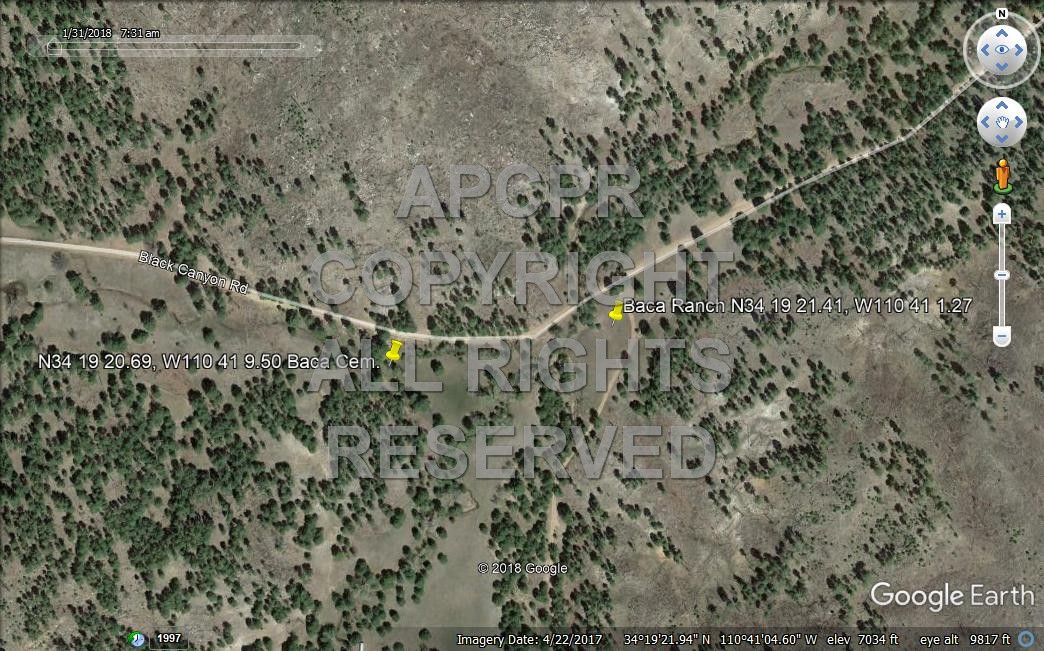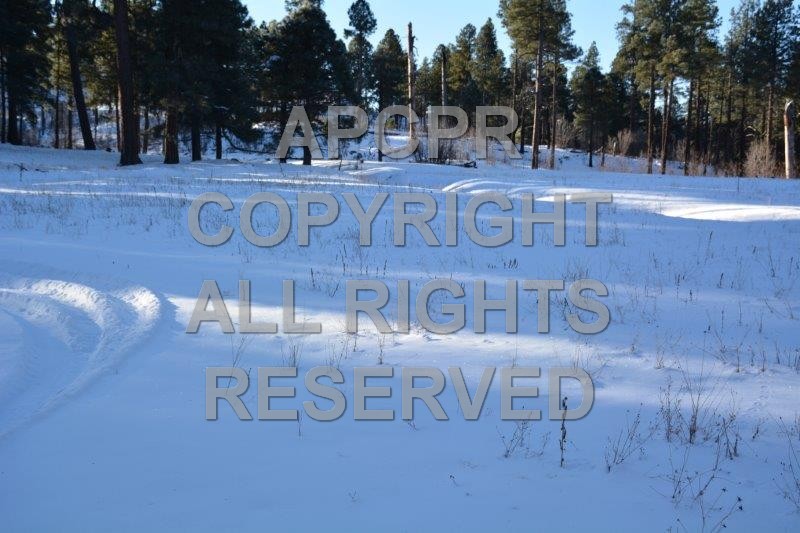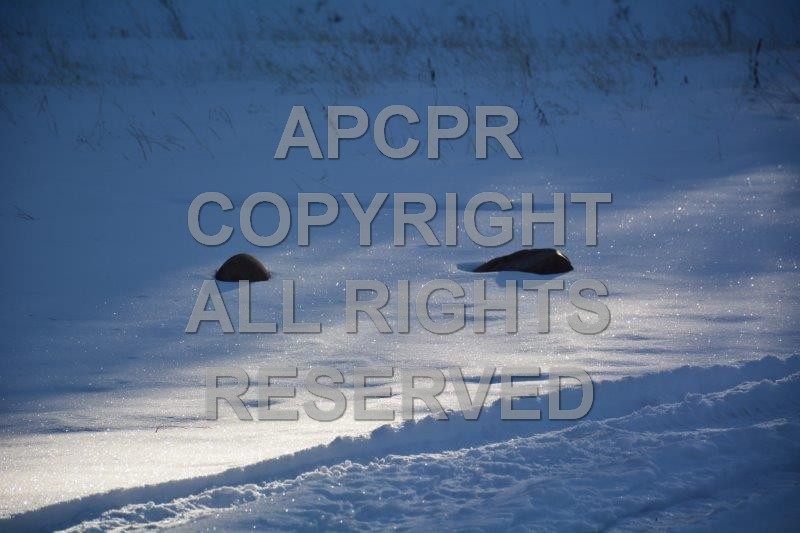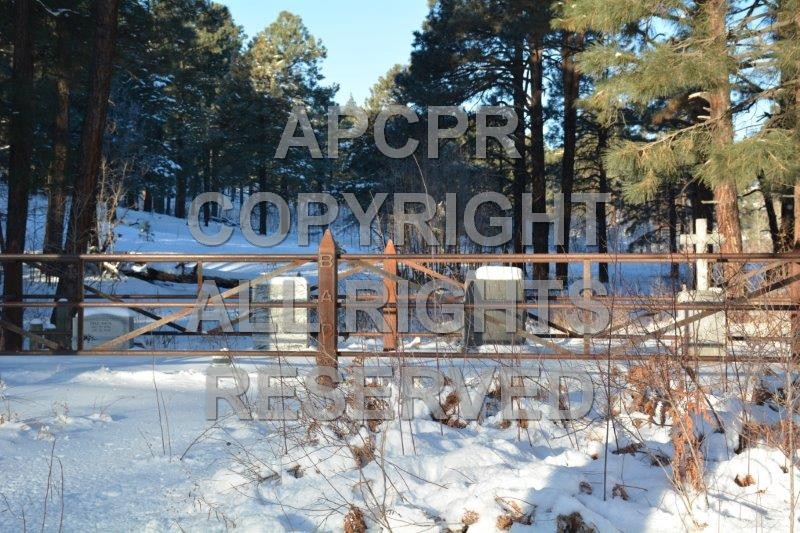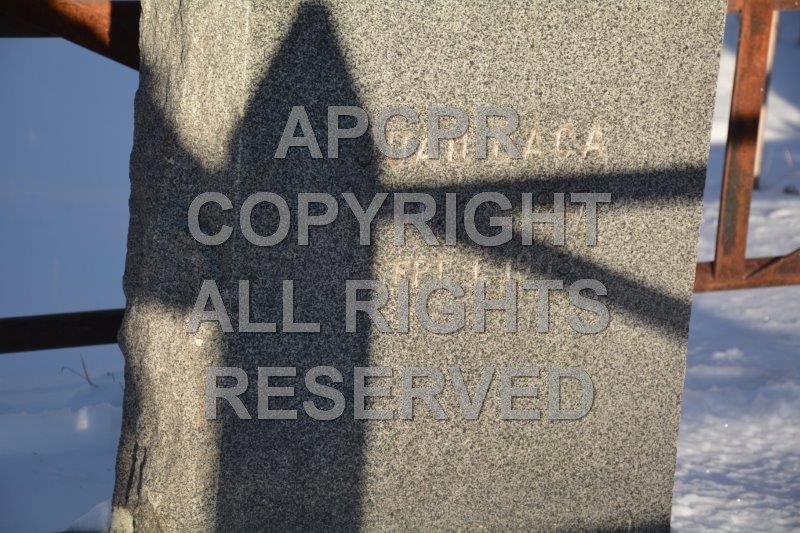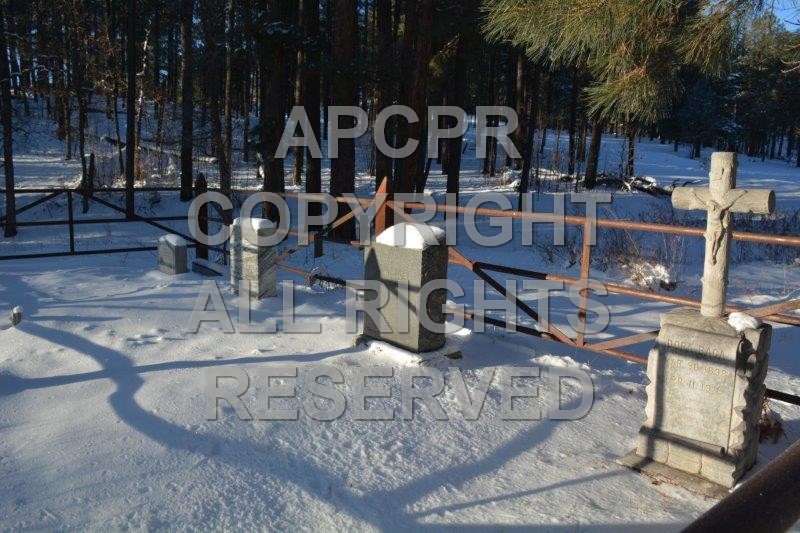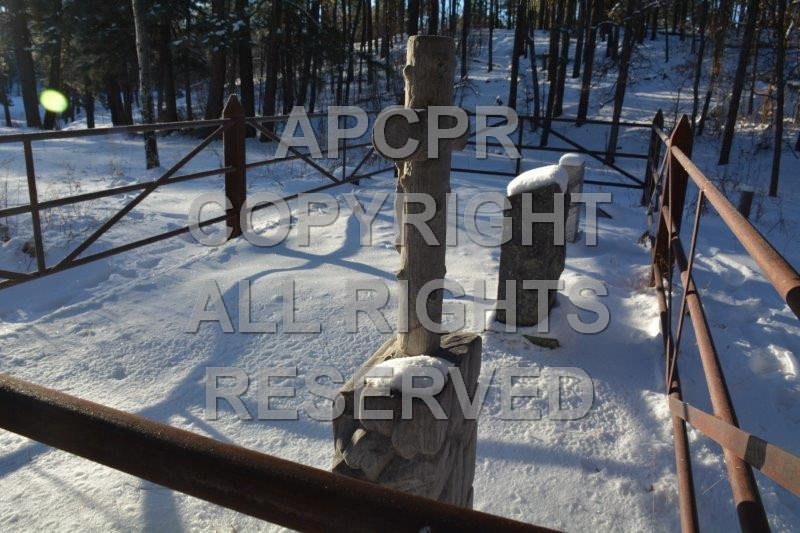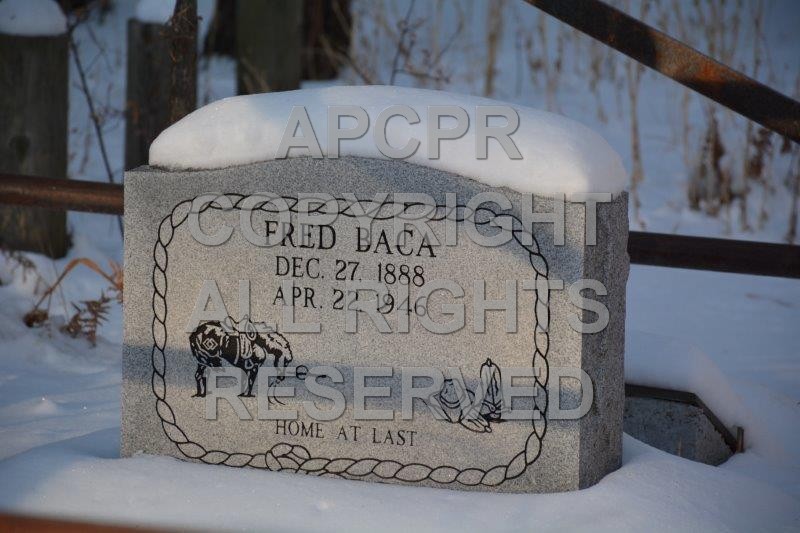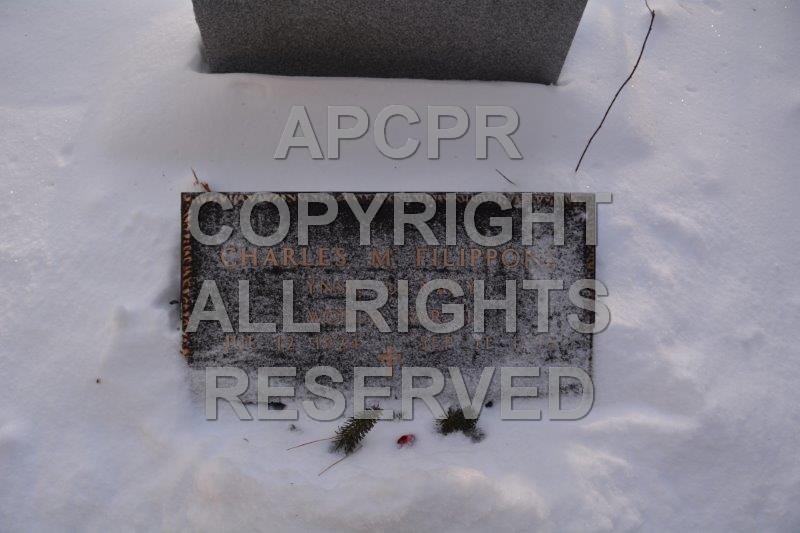HOME | BOOSTER | CEMETERIES | EDUCATION | GHOST TOWNS | HEADSTONE
MINOTTO | PICTURES | ROADS | JACK SWILLING | TEN DAY TRAMPS
AMERICAN PIONEER
& CEMETERY RESEARCH
PROJECT
BACA RANCH AND CEMETERY
NAVAJO COUNTY, ARIZONA
APCRP Internet
Version 020218
By: Kathy
Block
APCRP Staff Historian
The Baca Ranch and Family Cemetery are located
in the Apache-Sitgreaves National Forest on a historic wagon trail that
connected Pleasant Valley and Heber. This trail is now known as "Black Canyon
Trail." The cemetery is next to an area known as Baca Meadows. The ranch was
located 800 feet east of the cemetery. Sadly all traces of the former ranch
homestead has been removed by the Forest Service. At an altitude of 7,029 feet
above sea level. The cemetery occupies a retained one acre on private land that
is owned by the Baca family for their family’s historical preservation and
future use. Help preserve this place of history - take only photographs - leave
only foot prints – pay your respects - do not trespass.
|
|
Location of Baca Family Cemetery and Baca Ranch. Courtesy of
Neal Du Shane.
Baca Ranch was established when Juan Baca Y
Montano and his wife Damasia Torres moved to
homestead land in 1889 recommended by John Nelson, who had a sheep ranch just
west of Heber, and for whom Juan hauled wool. Juan and Damasia
were married on December 12, 1867 in Belen, New Mexico, and lived, with three
daughters, in various places in Arizona Territory until they established Baca
Ranch.
The name "Baca" probably derives from
a Spanish variant of the Romanian "Baciu"
meaning "Shepherd." But, also,
a Hungarian nickname from "baca" means
"obstinate." (Dictionary of American Family Names,
2013, Oxford University.)
Damasia Baca's father, Pablino Torrez, and his wife were from Spain as were her
husband Juan's parents.
According to Molly Bejarano (APCRP Researcher) the "Y Montano" means "and
or plus" indicating he was the son of a woman with the "Montano"
surname. This was something members of more prominent families did, as they
were bound by their families to marry within specific families. In many Mexican
church records, the "Y" between names may be left out.
Juan built a small log cabin and began farming
and ranching. As his family grew, he added rooms to the cabin and connected
them with walkways. He also built a cellar to store his bumper vegetable crops
from a first wet summer.
The family had seven girls and a boy. Four
years later, on September 1903, Juan died from heart trouble and the son, Fred,
age 15, became "man of the house."
Single women were scarce in the Arizona Territory.
Since there were seven daughters, eligible bachelors often stopped at Baca
Ranch off the Black Canyon Trail. John Nelson, who married Mollie Baca in 1898,
built a new road from his sheep ranch near Heber to the Black Canyon Trail to
save an hour on his courtship trips. This road became known as the "Dugway" due to the effort by John and others to build
it!
A Forest Service interpretive sign at the Baca
Ranch site states that: "Damasia was known for her hospitality. Situated right on
the wagon trail that connected Pleasant Valley and Holbrook, many visitors
passed by. It was said that Damasia would even run
outside and beg a stranger to stay and 'eat a bite' before driving on. Also:
“Fear on this often hostile frontier was
not something that filled Damasia's heart. She
befriended the Apaches, speaking to them in Spanish, and they were said to have
been very protective of her."
Harsh winters often isolated the Damasia and 5 of her children for 4 months, with snowfall
up to 150 inches (12’.6”) .
A news item from the St. John's Herald and Apache news,
March 4, 1915, mentions the difficulty of travel in the area: "Sheriff Lee Newman and J. W. Lockhart
returned Friday from a ten days' hunt for cattle rustlers, following the trail
over into the Pleasant Valley and the Tonto country. Sheriff Newman states that
the snow is from two to four feet deep in the mountains and it is almost
impossible for even saddle and pack outfits to get through. One pack outfit
crossing from Baca's ranch to Ramer’s, a distance of 12 miles, were two days on
the road.
|
|
|
January 2018 - (L) Baca Ranch former homestead. (R) Foundation stones after snowfall. Photos courtesy Neal Du Shane
Dancing was a favorite pastime for the family
and they frequently had parties where they danced through the night. Social
life continued after the death of Juan in 1903. Early newspaper accounts,
especially in the Holbrook News, often mentioned visitors and social events at
the Baca Ranch. Here are a few:
"Chuck
Badden returned on Monday from a fortnight's vacation
which he spent in Heber, the guest of the Baca Ranch, and in the White Mountains."
The Holbrook News, July 25, 1913.
"Mrs.
Jane Morgan, who was a sojourner in Holbrook during the winter months,
accompanied by Mrs. L. S. Heward, left last Friday
for Heber where she is a guest at the Baca Ranch, Mrs. Heward
said that it began snowing on them before they reached Heber and that they
traveled through a heavy snow storm. She describes the scene along the road to
Heber as one of splendid beauty at this time of year, the White mountains being
covered with snow and dotted with a profusion of early blooming wild
flowers." The Holbrook News, April
3, 1914,
"Attend
Dance at Heber: Mrs. Geo. W. Hennessey, Misses Bertha, Annie and Minnie
Wallace, and Mr. Max Henderson motored to Heber last Tuesday to attend a dance
given at the Baca Ranch. A delightful outing was enjoyed by the jolly
party." The Holbrook News, July 18,
1919.
"The
Misses Rosa Scorse and Amelia Nuanez,
accompanied by H. S. Moore, made an auto trip to Baca's ranch near Heber,
leaving here Friday evening and returning Sunday. They report having a delightful
time and no casualties." The
Holbrook News, June 25, 1925.
Mamie Baca (April 14, 1886 to August 15, 1955)
was postmistress for Heber from 1908 to 1910, with an office at Baca Ranch,
bringing in some income. She later married Thomas Benjamin Longwellon
at the ranch on June 26, 1913.
Before the estate could be settled after Juan
Baca's death, the Holbrook Argus, October 17, 1903 reported: "On information received by the (Tax) Board
it appears the widow and children of Juan Baca recently deceased of Heber are
in straightened (sic) circumstances and the taxes assessed to same are hereby
cancelled to widow."
A month later there was a probate notice in the
Holbrook
Argus, November 14, 1903. In the notice it said: "In the matter of the Estate of Juan Baca Y
Montano, Deceased, Notice is hereby given that Damasia
Baca has filed in this court a certain document purporting to be the last will
and testament of Juan Baca Y Montano, together with her petition praying that
the same be admitted to probate and that letters testamentary be granted
herself."
The end of the Baca Ranch ownership came in 1931.
Damasia Baca sold the ranch to the A.& B.
Schuster Company and moved in with daughter Lucy who was married to Burke
Clifton Prince and living on Turkey Springs Ranch. Two years later Damasia became ill and moved to Mesa to live with her
daughter Mollie and husband John Nelson in Mesa. Damasia
died in Mesa at Mollie's home on March 24, 1934.
The ranch was sold again in 1936 to C. B.
Brunson, owner of the OW Ranch at Canyon Creek, and resold in 1939 to W.W. Jay
of Ken's OW Cattle Company. In 1951 the Biglers of
Heber bought the ranch, then sold it in 1955 to Michael Purcell. He swapped
land with the Forest Service, who tore down/removed the ranch buildings,
possibly to deter squatters. The one acre parcel with the graveyard was
returned to the Baca family.
|
|
Jan. 2018, Baca Family Cemetery, "BACA" welded in metal post. Photo by Neal Du Shane.
Baca Family Cemetery was established in the
fall of 1903 to bury Juan Baca Y Montano, the
founder, with his wife Damasia, of Baca Ranch. Juan
was born April 28, 1847 in Belen, Valencia County, New Mexico. The "Y Montano"
means "and or plus" indicating he was the son of a woman with the "Montano"
surname. This was something members of more prominent families did, as they were
bound by their families to marry within specific families.
JUAN BACA DEAD. Word was received here yesterday morning telling of the
death at his ranch near Heber, Arizona. The end came at 12:30 a.m. last Tuesday
and was caused by heart trouble. The deceased had been a resident of Arizona
for many years and was well known throughout Apache and Navajo counties. He
leaves a wife and eight children to mourn his loss. Three of the daughters are
married: Mrs. E. S. Perkins and Mrs. Benjamin Schuster of St. Johns, and Mrs.
John Nelson of Heber. Mrs. Perkins left here the 29th of last month and got to
Heber a day or two before her father's death. The deceased was buried on his
ranch. Much sympathy expressed for the bereaved family." Snips and the St. John's Herald, September 15, 1903.
|
|
Juan Baca's Headstone. Photo by Neal Du Shane.
|
|
Juan Baca Y Montano
DORA BACA was the second burial in
Baca Family Cemetery. She was born March 30, 1898 to Juan and Damasia Baca in Heber.
She died April 11, 1916 from
progressive pneumonia, and septicemia, in Mesa. Arizona. There were several
obituaries in local papers. (Note some of the language!)
"Miss Dora Baca, of Heber, daughter of Mrs. Juan Baca, died
at Mesa on Monday. Miss Dora was a beautiful young lady, eighteen years of age,
and was spending the winter in Mesa with her sister, Mrs. John Nelson,
attending school. The funeral services were held at that place and the remains
shipped here and taken to Heber for burial at the ranch home of the family.
Five automobile loads of relatives and sorrowing friends from Phoenix, Alamogordo,
N.M. and this vicinity, followed the corpse from here to its last resting place
in the mountains, a distance of sixty miles. The burial was a very simple but
impressive affair and at its close the grave was covered with a profusion of
flowers tendered at the funeral by sorrowing friends of Mesa." St. John's
Herald, April 27, 1916.
Another obituary said:
"Miss Dora Baca, who has been ill for some days with
pneumonia died yesterday at 3 p.m. at the Southside hospital. Miss Baca's case
was from the first considered a very serious one and each passing day saws an
almost hopeless fight....Her lovable disposition had endeared her to a bunch of
friends..." Arizona Republican,
April 12, 1916.
More details from the Arizona
Republican, April 13, 1916: "Funeral
services of Miss Dora Baca who died Tuesday afternoon of pneumonia will be held
at the residence of Mr. John Nelson this afternoon at two o'clock. The regular
priest for the Catholic Church of Mesa will be down from Phoenix and conduct
the service. The body will be interred in Heber, the birth place of Miss Baca.
The city is saddened at the taking away of this young girl in the very morning
of her life, and the sympathy of all goes out to the sorrowing relatives who
will miss so sorely the girlish laughter and the bright sunny presence of their
loved one."
Dora Baca's headstone is the
tallest and most elaborate in the Baca Family Cemetery. An inscription at the
base of a figure of Christ on the cross says: "Just as the morning of life was opening unto day, her young and lovely
spirit passed from earth and grief away"
|
|
Headstone Dora Baca's grave, Photos by Neal Du Shane.
Damasia Torres Baca was the third burial in the Baca Family
Cemetery. She was born on December 12, 1857 (D.C. says 1858) in Belen, New
Mexico. She died in Mesa at her daughter's home on March 24, 1934 and buried in
the Baca Family Cemetery. The cause of death was hypertension, chronic
nephritis, apoplexy. She remained a widow after Juan's death.
|
|
|
|
|
|
The fourth headstone in Baca Family
Cemetery, Fred Baca is actually only
a memorial. His burial place with a pink granite headstone is in the IOOF Cemetery in Lebanon, Oregon. The headstone in Oregon
has a cross with flowers on each side, the inscription "PAPA, FRED BACA,
Dec.27, 1888 to Apr. 22, 1946. Angels called him." He was born in
Holbrook, Arizona and died in Lebanon, Oregon where he'd lived and worked as a
ship fitter for ten years. He and Aurelia (b. July 17, 1894 in Concho, Arizona,
died Feb. 12, 1985 in Sacramento, Cal.) had 5 children. According to his Oregon
Death Certificate, Fred Baca died from disease of coronary artery and angina
pectoris.
During his lifetime, there were
many mentions of him in the local newspapers.
For example: "Fred Baca and Clarence Morrow arrived in town Sunday, Mr.
Morrow's car having broken down near Heber, and Mr. Baca pulled it in with a
team. Mr. Morrow started for Flagstaff Monday after having his car repaired at
a local garage. Fred Baca stayed over for the cattle man's meeting." The Holbrook News, January 29, 1915.
World War I began and Fred Baca
applied to a district board for an exemption to the draft. "The claim of Fred Baca, Navajo County, because of stock raising
and farming, was denied unanimously by the Board." Arizona Republican,
August 22, 1917.
On June 21, 1918, the Holbrook
News reported that "Fred Baca,
who has been in the training camp at Camp Funston since his enlistment, is now en route to join the American forces in France. He has written the News to forward his paper
to France."
Almost a year later, on June 12, 1919, the Holbrook News announced that: "Fred
Baca returned Wednesday from overseas Service, having come direct from Prum, Germany, where his contingent of the 56th Division,
Army occupation, has been stationed. He states that 'tickled' does not express
his joy at returning to Arizona. A gain of some 20 pounds in weight is a result
of army life, from the time of his enlistment with the first 5 percent
contingent in 1916 to date."
When Fred was married April 7, 1920
in Holbrook, Arizona, this article describes the event:
"The marriage of Miss Aurelia Ortega and Fred Baca occurred
last Wednesday....The ceremony took place in the Catholic Church here. Rev.
Father Albouy officiating. The young folks were the
recipients of many presents and the congratulations of all. In the evening, at
the Pastime Theater, there was a large crowd present at the dance given in the
honor of the young couple and a most enjoyable time was had. Both the young folks are well known in this
section, the bride being the daughter of Mr. and Mrs. Thomas Ortega for year’s
residents of the community." The St. John's Herald, April 15, 1920.
The Holbrook News, April 9, 1920, added a few details: "An elaborate wedding breakfast at the home of the bride's
parents, followed the ceremony....Mr. and Mrs. Baca will reside on their ranch
near Heber after a short honeymoon trip."
Some year and a half after his marriage, Fred Baca bought a car!
"Franklin
continues to sell cars at about his customary rate. I.E. Richards purchased a Willys Knight, also Chas. Payne is the proud owner of a
Knight. Model 4's were bought by the following: Fred Baca and a passenger
engineer, whose name we did not get." The Holbrook News, December 16,
1921.
|
|
Plaque for Charles Michael Filipone. Photo by Neal Du Shane
Twenty years after Fred Baca's
death, Charles Filippone
was buried in Baca Family Cemetery. Charles Michael Filippone
was born July 12, 1924 in Audubon, N.J. and died September 11, 1988, in
Phoenix. He was the husband of Mary Filippone, whose
photos appear in Leland Hanchett, Jr.'s book: The Crooked Trail to Holbrook.
Arrowhead Press, Phoenix, 1993.
Charles Filippone
was married on July 17, 1945 to Mary Lee Prince in Vancouver, Washington. Mary
was the daughter of Lucy Charlotte Baca Prince (April 21, 1893 to March 3,
1975). Lucy was one of the daughters of Juan and Danasia
Baca and married Burke Clifton Prince on Nov. 10, 1920. (He was born March 10, 1891
in Bolton, Texas, and died Jan. 7, 1946 in Portland, Oregon.)
Charles Filippone
was a veteran of WWII. His headstone, a flat brass plaque, reads: CHARLES M. FILIPPONE YNSN US NAVY WORLD WAR II.
Jul.12, 1924 Sep.11, 1986.
An obituary in Arizona Obituary Archives lists William Clifton Filippone,
Nov. 24, 1950 to Nov. 12, 2003, who died from cancer in Overgaard, He was the
son of Charles Filippone Sr. and the obituary says
"Bill was a descendent of Juan and Damasia Baca of Baca Ranch and Cemetery in Heber. Bill was
preceded in death by his father, Charles Filippone
Sr." Memorial services were at the American Legion in Overgaard .No
burial place listed.
A final, most recent burial in Baca
Family Cemetery is somewhat mysterious. PAULA
THOMPSON, 1925 to 2011, is listed on Find A Grave.
The only information found is that she MAY be a daughter or relative of Mamie
Baca (April 14, 1886 to Aug. 15, 1955) or her husband. Mamie married Thomas
Benjamin Longwellon on June 26, 1913 at Baca Ranch
and had 7 children between 1915 and 1927, plus "Paula" listed on a genealogical
research site. It is unknown if there is a plaque or marker for her. Possibly
later research will identify Paula Thompson's grave site.
The area around Baca Family
Cemetery and Baca Ranch is surrounded by a beautiful meadow with many Aspen and
Pine Trees. The history of this family is represented in the stories of members
buried there. I recommend, "The Crooked Trail to Holbrook"
by Leland Hanchett, Jr. for detailed information about the Baca family and Baca
Ranch. This book is available in many libraries or on-line book sellers.
A greatful appreciation to
those who aided me in research.
Neal Du Shane, who drove thru
snow and ice to the sites. Photographed and researched the cemetery and ranch
site. Whose photos are gratefully used in this article.
My cousin Carmen Rickert, who did extensive helpful genealogical research on
the Baca family.
Leland Hanchett, Jr. author of "The
Crooked Trail to Holbrook," who generously answered inquiries, regarding the cemetery and ranch.
Some information was found on various
Baca Family Genealogical sites and forums on the Internet, and miscellaneous
articles on hiking sites. The interpretive plaque at Baca Ranch site also had
useful information.
News articles are from
"Chronicling America" Library of Congress on the internet.
American Pioneer
& Cemetery Research
Project
WebMaster:
Neal Du Shane
n.j.dushane@apcrp.org
Copyright
©2003-2018 Neal Du Shane
All rights reserved. Information contained within this website may be used
for personal family history purposes, but not for financial profit or gain.
All contents of this website are willed to American Pioneer & Cemetery
Research Project (APCRP).
HOME | BOOSTER | CEMETERIES | EDUCATION | GHOST TOWNS | HEADSTONE
MINOTTO | PICTURES | ROADS | JACK SWILLING | TEN DAY TRAMPS
